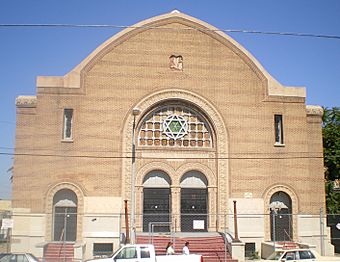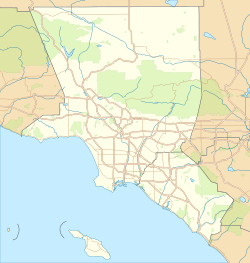Breed Street Shul facts for kids
|
Congregation Talmud Torah of Los Angeles
|
|

Breed Street Shul
|
|
| Location | 247 N. Breed St., Los Angeles, California |
|---|---|
| Built | 1915 or 1923 |
| Architect | Abram M. Edelman |
| Architectural style | Byzantine Revival; Late 19th and 20th Century Revivals |
| NRHP reference No. | 01001192 |
Quick facts for kids Significant dates |
|
| Added to NRHP | November 4, 2001 |
The Breed Street Shul, also known as Congregation Talmud Torah of Los Angeles, is an Orthodox Jewish synagogue in the Boyle Heights area of Los Angeles, California. A "shul" is another word for a synagogue, which is a Jewish house of worship.
From 1915 to 1951, it was the biggest Orthodox synagogue west of Chicago. Today, it is listed on the National Register of Historic Places, which means it's an important historical site.
Contents
The Shul's Beginnings
Congregation Talmud Torah started in 1904. At first, they met in a rented building in downtown Los Angeles. "Talmud Torah" usually means a religious school for Jewish children. However, this group also used the space as a synagogue for prayers.
After a few years, many Jewish immigrant families moved to Boyle Heights. Some people bought a house on Breed and First Street and started using it as a shul. By 1914, the old location was not used much anymore. So, the members joined the new group on Breed Street.
In 1915, they bought land nearby and built a new wooden building. This became known as the "Breed Street Shul." More students joined, and by 1918, they needed a second building. By 1923, there were 110 students attending. The Jewish population in Boyle Heights grew a lot during these years.
Building the Main Synagogue
As more people joined, a larger synagogue was needed. A new brick building was designed by architects Edelman and Barnett. The original wooden building was moved to the back of the property to make space. The new main synagogue opened in 1923.
The new building was made with strong brick walls. It had special decorations on the outside, like different colored bricks and carvings of plants. It also featured Stars of David carved into the stone.
A Center for the Community
From 1910 to 1950, Boyle Heights was home to Los Angeles's largest Jewish community. The area around Breed Street Shul became a very important center for Jewish life.
Nearby, on Brooklyn Avenue (now Cesar Chavez Avenue), there were many Jewish businesses. These included kosher butchers, bakeries, delis, and bookstores. The street where the Shul was located also had the Los Angeles Jewish Academy, a school, and the Mount Sinai Clinic, a health center.
In 1945, Rabbi Osher Zilberstein of Breed Street Shul opened the city's first Jewish elementary school. When Israel became an independent country in 1948, the Breed Street Shul was chosen for a special ceremony. The new flag of Israel was flown there for the first time in Los Angeles.
Changes in the Community
After World War II, many Jewish families began to move out of Boyle Heights. They moved to other parts of Los Angeles, like the Fairfax District and Encino. Rabbi Zilberstein stayed at Breed Street Shul until he passed away in 1973.
Empty and Needing Repair
The main brick building of the Shul was closed in the mid-1980s. This was because it needed special upgrades to make it safer in an earthquake. Services then moved to the older wooden building at the back. By 1996, services stopped completely at Breed Street Shul, and the buildings have been empty since then.
Becoming a Historic Landmark
In 1988, the building was named a City of Los Angeles Historic-Cultural Monument. This means it's an important part of the city's history.
Even with this honor, the building continued to fall apart in the 1990s. In 1998, Hillary Clinton visited the Shul as part of her "Save America's Treasures" program. This program helps protect important historic sites.
In 2000, a group called Breed Street Shul Project, Inc. took over the property. They plan to fix up the buildings and turn them into a museum, education center, and cultural center for the community. In 2001, the Shul was also added to the National Register of Historic Places.
Important Rabbis
Solomon Michael Neches (1921–1935)
Rabbi Solomon Michael Neches was born in Jerusalem. He was the first rabbi of the synagogue when it was called Congregation Talmud Torah. Rabbi Neches worked hard to make sure Jewish children in the community received a good Orthodox religious education. He also helped create California's first Kosher Law, which sets rules for preparing food according to Jewish dietary laws.
Osher Zilberstein (1935–1973)
Osher Zilberstein was a very respected Torah scholar. He became the rabbi of the Breed Street Shul in 1935. Rabbi Zilberstein was important in opening an Orthodox day school called Yeshivas HaMaarav. He served the community for many years until his death in 1973.
Cantors
Cantor Israel Reich served the Breed Street Shul from 1946 to 1953. A cantor is a person who leads the congregation in prayer and song. He was known for helping many students, including his own children, become cantors themselves.





